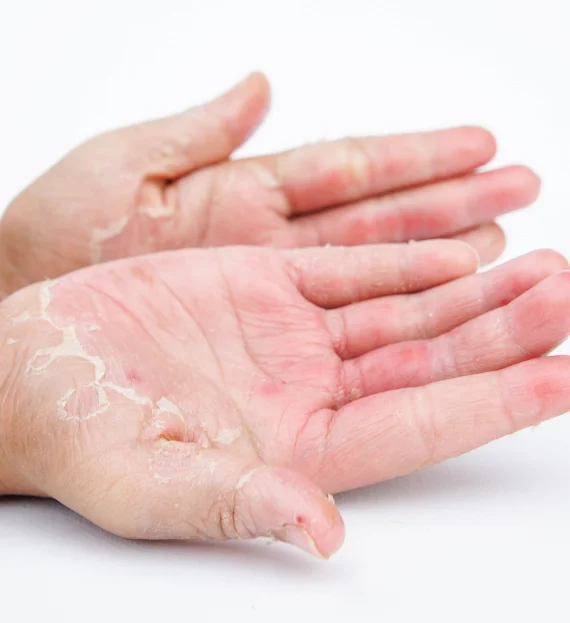Tinea Infections are caused by fungus- Tinea; commonly called as ringworm infection affecting skin, hair, and nails. Tinea infection’s symptoms are redness, itchiness, and a scaly patch with raised rashes.
Candidiasis are caused by fungus – Candida (yeast) affecting mucus membrane – mouth or diaper area. Candida infection’s symptoms are red, itchy patches on the skin or white patches in the mouth.
Athlete’s foot is a fungal infection of the foot’s skin, sole, or toes. The most common fungus causing it is Trichophyton which thrives on dead cells. The infection may appear like blisters, red, softened, broken down the skin, or scaly feet with peeling/cracking skin. One will also experience itching and burning sensations.
Jock’s itch is caused by Tinea fungus in the groin/inner thighs, thigh, and genitals as they are able to thrive in these warm and moist areas. The symptoms are an itching/burning sensation in the groin/thigh region, and the presence of a red, circular-shaped rash with raised edges.
Anti-fungal medications in oral/topical form are considered depending upon the severity of infection, site of infection, and even nature – recurrent/resistant. Paediatric dermatologists guide parents in following non-therapeutic or preventive measures for managing infections in children. These measures include following a hygienic lifestyle –
- keeping the affected area clean and dry
- wearing the breathable and clean clothes
no sharing of personal belongings like combs, socks, towels, underwear, etc.
Faq
Frequently Asked Questions
- Fungus is a type of microorganism that causes fungal skin infections. These microorganisms thrive in moist and warm environments. These infections are contagious in nature and spread through direct contact with an infected person or animal. Even unhygienic living habits like sharing combs, towels, and clothes can aggravate the condition or promote the spreading of infection.
A. Depending upon the affected skin part, the sign and symptoms appear. Some of the prominent ones are as follows-
· Itching
· Redness
· Swelling
· Scaly skin
· Irritation
In the case of fungal infection in the hairy region, one may experience hair fall whereas nail infection may show up discoloration.
A. One can prevent the fungal infection by completing the recommended treatment and following the preventive measures like –
· Keeping the affected area clean and dry
· Wearing breathable and clean clothing
· Avoiding sharing of personal belongs like – combs, towel, clothes, jackets, hats, scarf,
A. Yes, fungal infections can reoccur or resurface if the treatment is not completed as per recommendation or preventative measures were not followed properly.
A. Fungal infections have peculiar physical features which help dermatologists in diagnosing by conducting a physical examination. Sometimes, dermatologists may recommend a culture test (skin/hair/nail) for identifying the specific causative pathogen (fungus) in cases of recurrence or presence of traces of infection in spite of completion of recommended treatment
A. The fungal infections are treated with multiple approach – depending upon the severity and area of spread, topical/oral antifungal is prescribed along with recommendations on personal hygiene to curtail the spread of infection. Completion of treatment is stressed to prevent the recurrence and resistance to the treatment.
A. The fungal infections are treated with multiple approach – depending upon the severity and area of spread, topical/oral antifungal is prescribed along with recommendations on personal hygiene to curtail the spread of infection. Completion of treatment is stressed to prevent the recurrence and resistance to the treatment.






